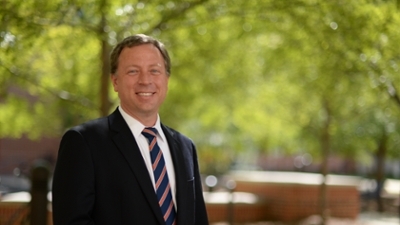Professor awarded NSF grant to develop high-speed, compact 3-D imaging technology

A research team led by Auburn Engineering professor Brian Thurow has been awarded a $1.1 million grant from the National Science Foundation to develop a new, single-camera imaging system capable of capturing high-speed and 3-D measurements in practical flow fields.
"From blood flow through artificial heart valves to the mixing and combustion of fuel and air in a modern jet engine, many flows are both unsteady and three-dimensional," Thurow said. "Modern diagnostics used to study these flow fields are slow, two-dimensional, and in the case of multi-camera 3-D diagnostics, both expensive and complex. We are trying to simplify fundamental 3-D imaging technology into a more compact and economical hardware, while also increasing the speed of the system to help us look at more practical problems."
In recent years, Thurow's lab developed a prototype that has been demonstrated as a simple, robust and effective 3-D imaging system. The grant will help researchers to develop the hardware and software of the technology, which allows them to capture all the information they need in one snapshot, using just one piece of equipment.
"In one click of the shutter, can you get all of the information about what's happening in three dimensions? The unique piece of what we're developing is that we don't have to have hundreds of cameras looking at an experiment at one time, and we don't have to move the cameras around to a number of different positions," Thurow said. "We can do it all in a simple, compact hardware, which will also allow the system to be optimized for various facilities and techniques."
Thurow said the technology will allow them to expand their research beyond aerospace to other areas including biomedical engineering and cardiovascular fluid mechanics.
"The system will have an immediate impact on the understanding and treatment of cardio/cerebrovascular diseases; the understanding and modeling of non-reacting compressible flow fields associated with high-speed vehicles; and the understanding and design of stable and efficient combustion processes," he said. "Long term, the technology will support collaborative research activities at both Auburn and Purdue University."
Other researchers involved in the project include David Scarborough and Vrishank Raghav, also of the Department of Aerospace Engineering, Stanley Reeves of the Department of Electrical and Computer Engineering, and Pavlos Vlachos of the Purdue University School of Mechanical Engineering.
"At Auburn, biomedical fluid dynamics, unsteady 3-D rotating flows and combustion instability are emerging topics being led by Vrishank Raghav and David Scarborough," Thurow said. "Our counterparts at Purdue have a track record of applying advanced diagnostics to high impact problems and are well established in their respective fields. There is this nice synergy between what they're doing and what we're doing. We are able to focus on the instrumentation and hardware development, and then the applications will push out through the work of our colleagues at Purdue. The collaboration is mutually beneficial."
Thurow is the W. Allen and Martha Reed Professor and chair of the Department of Aerospace Engineering in the Samuel Ginn College of Engineering.
Media Contact: , nelsoc4@auburn.edu, 334.844.3447
thurow headshot

